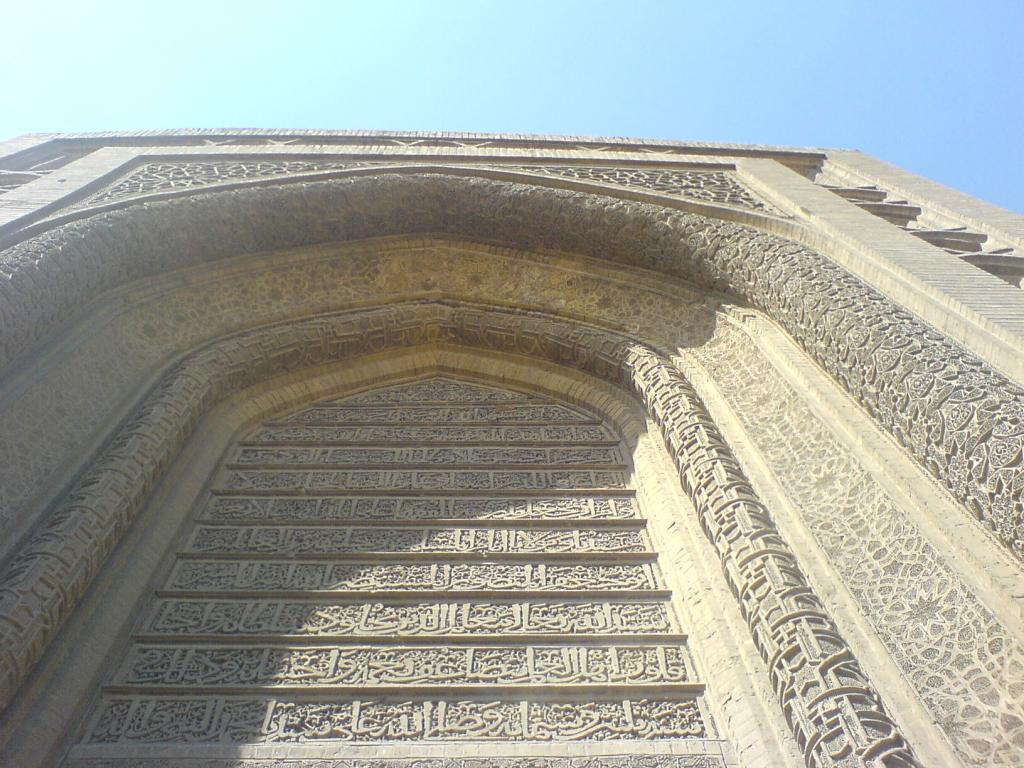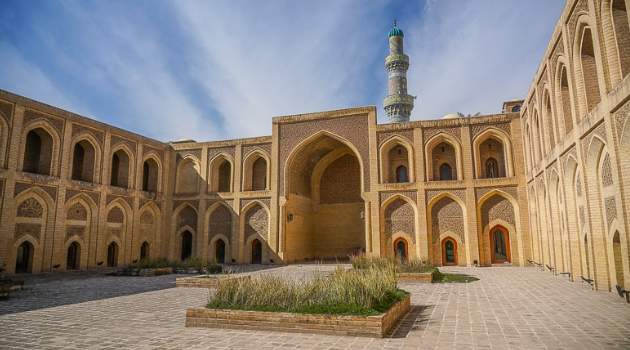Al-Mustansiriya Madrasa is a historical landmark located in the heart of Baghdad, Iraq. The madrasa, which was established in 1227 CE, is one of the oldest and most prestigious Islamic institutions of higher learning in the world. It was founded by the Abbasid Caliph Al-Mustansir and was named after him.
The madrasa was designed to be a center of learning for Islamic sciences, including theology, law, and Arabic grammar. It also offered courses in mathematics, astronomy, medicine, and philosophy. The curriculum was rigorous and demanding, attracting students from all over the Islamic world.
Over the centuries, Al-Mustansiriya Madrasa has produced many notable scholars and intellectuals. Some of the most famous alumni include the philosopher Ibn Rushd (also known as Averroes), the historian Ibn Khaldun, and the theologian Al-Ghazali.
The Mustansiriya Madrasa is one of the only buildings still standing that provides evidence for Baghdad’s role as a center for Islamic Art and for the city’s role in the development of geometric ornament. Situated on the Tigris River, this brick, two-story, rectangular madrasa is organised around a central courtyard. Three iwans open onto the court while the fourth side leads down a long corridor off of which are three open spaces that functioned as an oratory. The entrances exhibited arabesque-sculpted terracotta and geometric patterned masonry work, featuring vegetal themes that recall earlier Abbasid and even Umayyad motifs.

The Madrasa has experienced several periods of decline and reemergence throughout its history. The most significant degradation to the Madrasa’s architecture and position within Baghdad was the Mongol Siege of Baghdad. This great institution of medieval scholarship in central Baghdad was sacked by Hulagu Khan, a grandson of Genghis Khan, during the 1258 Mongol invasion, its students put to the sword, books dumped into the Tigris River, not unlike what happened recently upstream in Ninewa and Mosul, seven and a half centuries later, at the hands of Daesh terrorists. Under Hulagu’s leadership, the siege of Baghdad destroyed Baghdad’s standing in the Islamic world and ended the Abbasid Dynasty in 1258. The siege is also considered to mark the end of the Islamic Golden Age.
The school at one point had a library that contained some 450,000 books and volumes. Al-Mustansiriyah rose again and witnessed two more Mongol invasions of Baghdad, by Timur (Tamerlane) in 1392 and in 1400, in which all schools were sacked again. After the 13th century, the Madrasa experienced a period of decline in prominence, followed by fluctuating centuries of purpose and power. The widespread annihilation and conquest of the Mongols throughout the Middle East resulted in the first stages of transformation for the complex.

The madrasa has undergone many changes over the years, including renovations and expansions. However, it has managed to maintain its original character and architectural style. The main building features a central courtyard surrounded by four iwans (vaulted halls), which are decorated with intricate tilework and calligraphy.
In addition to its academic role, Al-Mustansiriya Madrasa has also played an important cultural and social role in Iraqi society. It has hosted many public events, including poetry readings, musical performances, and political debates.
In 1534, the Ottoman Turks sieged control, maintaining a stable reign until the British accession in the early 20th century. During the late 18th to the early 20th century, the Mustansiriya Madrasa was used largely for military purposes such as serving as a place of rest and resource, as well as a storage house for soldier uniforms. The building eventually became something of a caravanserai for traders passing through Baghdad. In 1865, the madrasa was converted to a customs office under the Ottomans.
In 1973, the Mustansiriya Madrasa was overseen by the Directorate of Antiquities in Iraq. Since then, the complex has been in a consistent state of reconstruction. The modern businesses surrounding the Madrasa have since been demolished with the intention of restoring the original perimeters of the complex and it is now a part of the Al-Mustansiriya University.
Al-Mustansiriyah Madrassa stands as a testament to Iraq’s resilience and endurance over the centuries and demonstrates that barbarism and terrorism of any kind, at any period, cannot prevail over culture and knowledge.
Despite facing many challenges over the years, including wars and political instability, Al-Mustansiriya Madrasa remains a symbol of Iraq’s rich cultural heritage and intellectual tradition. It continues to attract students and scholars from all over the world who come to study and learn from its rich history and legacy.


Looks like this building has witnessed a lot over all these centuries
LikeLiked by 1 person
Yes, the Madrasa withstood conflicts and the test of time. Most of the time the building was used for purposes other than educational.
LikeLike
Agree with your conclusion. Art should transcend violence.
LikeLiked by 1 person
Any idea what was its state under Saddam Hussein?
LikeLiked by 1 person
The restoration started in 1970s. Most of the Saddam regime Iraq was in war or under severe sanction… they had financial crisis although they are endowed with huge natural assets.
LikeLike
This is again a good amount of information on this beautiful structure. Sighting the political scenario and the unrest, Iraq is not considered as a favourite destination for tourism despite its numerous heritage structures and rich history. Just out of mere curiosity, have you been there for tourism purpose or work related?
LikeLiked by 1 person
I am in Baghdad in connection with work. You’re right the perception of Iraq is not very good outside the country, although the security situation has improved a lot. This country has a lot of tourism potential. Maybe, in future, it will pick up.
LikeLiked by 1 person
You have captured the whole story.
You seem to be a Historian.
Regards
LikeLiked by 1 person
Thanks, Shiva.
LikeLike